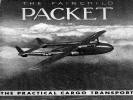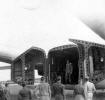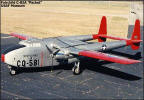|












| |
      
|
Post Combat Jumps |

First Look
The Hq 2nd Morning Report of 8 Apr 45 mentioned observation of a
new aircraft at Chartres with doors on both sides and misidentified it as a
C-46.
The C-46, which had a single door, had been in service for a number
of years but the newly available C-82 matches the verbal description.
|
|
 Barger's
Album contained two historic photos of a little known aircraft - the C-82. Barger's
Album contained two historic photos of a little known aircraft - the C-82.
The World War II era Fairchild C-82, named "Packet" was designed to
meet a need for an aircraft with large capacity cargo and loading at near ground level. The
prototype first flew on Sept. 10, 1944. Deliveries began in late 1945 and
ended in Sept. 1948; Only 223 Packets were built, all but four were
A-models.
The Packet's primary use was for cargo and troop transport, and often for
paratroop operations. Capacity was 41 paratroops or 34 stretchers and it
could also tow gliders. Clamshell rear doors allowed ease of entry for trucks, tanks,
artillery, and other bulky cargo.
After the formation of the U.S. Air Force in September 1947, some C-82s
were assigned to Tactical Air Command troop carrier squadrons and others to
Military Air Transport Service (MATS). But, the C-82 Packet proved to
be disappointing in its overall performance and reliability. |

"C-82" (Unidentified men, all wear 508th insignia)

Fairchild C-82 Ad |
|

"C-82" (This aircraft had far more room than the C-47 and
bigger twin doors to jump from.) |
 On 16 September 1948, five C-82s were assigned to the Berlin Airlift for the
purpose of carrying heavy and bulky cargo. The C-82 with its hangar-like
compartment and clamshell rear loading doors was an ideal tool for the
Airlift, but was not available in sufficient numbers to make a great
contribution. The aircraft's main contribution to the airlift was it's
ability to carry vehicles into the city without disassembly.
On 16 September 1948, five C-82s were assigned to the Berlin Airlift for the
purpose of carrying heavy and bulky cargo. The C-82 with its hangar-like
compartment and clamshell rear loading doors was an ideal tool for the
Airlift, but was not available in sufficient numbers to make a great
contribution. The aircraft's main contribution to the airlift was it's
ability to carry vehicles into the city without disassembly.
The C-119, developed from the C-82 and widely known as "The Flying
Boxcar", was designed to carry cargo, personnel, litter patients, and
mechanized equipment, and to drop cargo and troops by parachute. This widely
used twin-boom transport was a more powerful development of the C-82,
powered by the R-3350 or R-4360 radials and quickly displaced the few C-82s
in service..
Of the 233 C-82s built, 13 were lost in accidents between 1951 and
1977. Only the two in 1951 were under U.S. Air Force operation, all
others were of foreign registry, a reflection of the phasing out of the C-82
as the replacement C-119's became available. |
|





